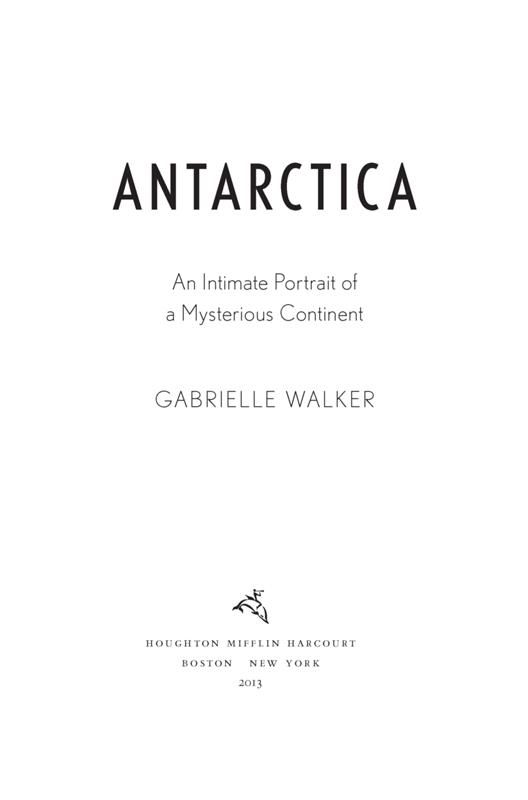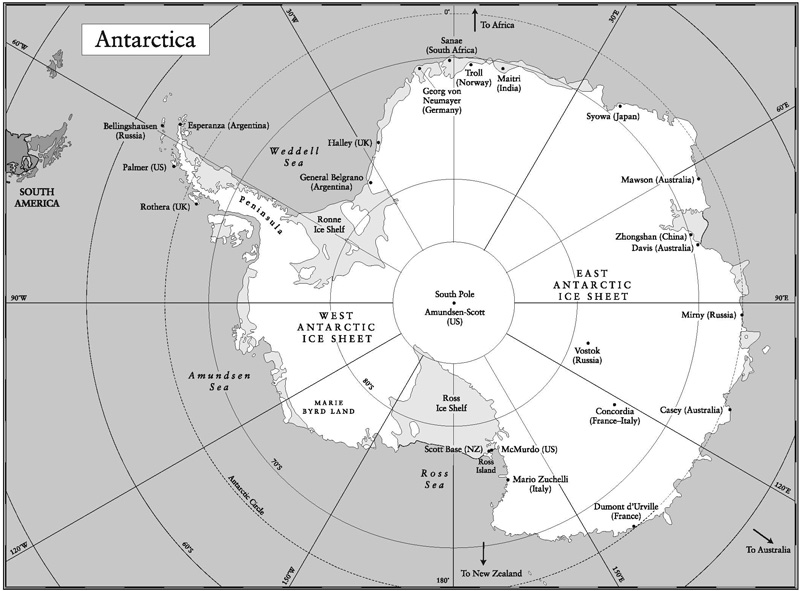Antarctica
Authors: Gabrielle Walker


Suggestions for Further Reading
Copyright © 2013 by Gabrielle Walker
Â
ALL RIGHTS RESERVED
Â
For information about permission to reproduce selections from this book, write to Permissions, Houghton Mifflin Harcourt Publishing Company, 215 Park Avenue South, New York, New York 10003.
Â
Â
First published in Great Britain by Bloomsbury Publishing, 2012
Â
Library of Congress Cataloging-in-Publication Data is available.
ISBN
978-0-15-101520-7
Â
e
ISBN
978-0-547-53697-2
v2.0314
Â
Â
Â
Â
For Fred and David,
my bookends
Â
Â
Â
Â
All lose, whole find
Â
âe. e. cummings

Antarctica is like nowhere else on Earth. While there are other wild places or ones that seem extreme, this is the only continent in the world where people have never permanently lived. In the interior of the continent there is nothing to make a living fromâno food, no shelter, no clothing, no fuel, no liquid water. Nothing but ice.
People have long suspected there may be some kind of land at the bottom of the world. The Greeks believed in Antarctica saying, with the peculiar logic of philosophy, that there must be a far southern continent to balance out the land in the north. Poets and novelists dreamed up new races of humans inhabiting tropical southern lands, or a hole at the South Pole that gave access to a hollow Earth beneath.
They were free to dream. The great sailing expeditions of discovery, which showed European powers the new worlds of the west and the ancient ones of the east, were always forced to turn back if they travelled too far south; they were blocked by the great ring of impenetrable pack ice that circles the southern seas.
The first sighting of the continent's outermost islands in 1819 did little to stop the speculation of what might lie beyond, and the first serious attempts to penetrate its interior took place barely a hundred years ago, in the heroic age of exploration by Scott, Amundsen, Shackleton and the rest.
Even now, although this land is bigger than Europe or the continental US, it has only forty-nine temporary bases, most of them on the relatively accessible coast.
1
In summers there are perhaps three thousand scientists on the ice, plus another 30,000 tourists who come in on short visits, usually by ship to the western Peninsula. In winters, there can be just a thousand people on the entire continent.
The scale of the place is hard to grasp. You see a mountain or an island that seems a few hours' walk away and decide to wander over and explore; five days later you're still walking. The early explorers did this a lot. The problem is not just the size of the featuresâglaciers that make Alaska look small, mountains that dwarf the Alpsâbut also the absence of anything against which to judge them. There are no trees, or indeed plants of any kind; no land animals; nothing but glaciers, snowfields and sepia-toned rocks.
In spite of its size, Antarctica officially belongs to nobody. An international treaty, signed now by the forty-nine countries with a declared interest, forbids commercial exploitation and dedicates the entire place to âpeace and science'. Thus, the continent is a science playground. Dozens of countries have gained themselves a placeholder for any future exploitation by building bases whose presence is justified by the noble pursuit of science. But whatever the true reasons that governments pump money into Antarctic science, the results extend far beyond the continent itself. Discoveries made there have dramatically changed the way we see our world.
For these reasons and many more I have been fascinated by Antarctica for more than two decades. I have visited five times, mainly as a guest of the huge American programme, run by the US Government's National Science Foundation, through whom I spent several stints at the South Pole, stayed for four months at McMurdoâthe main American base on the coast and the unofficial capital of Antarcticaâand visited many of the US field camps scattered around the continent. I've also been a guest of the Italian, French, British and New Zealand governments. I've sailed to Antarctica at various times on a tourist ship, a British Royal Navy icebreaker and a science research vessel. I've driven on the ice in tractors, snow dozers, skidoos and strange tracked vehicles with triangular wheels, and flown over it in helicopters, Hercules transport planes and small ski-equipped Twin Otters.
And in all these experiences I have encountered some astonishing stories. Antarctica has much, much more than just ice and penguins. It is like walking on Mars; it is a unique window into space; it has valleys that time has forgotten; mysterious hidden lakes; under-ice waterfalls that flow uphill; and archives of our planet's history that are unrivalled anywhere else on Earth. It is also a place of romance, adventure, humour and terrible cost. Since there is no prior culture or indigenous population, modern humans can write themselves afresh. For the people who go there, Antarctica is a carte blanche.
Even its apparent barrenness is a large part of its power. People are drawn to Antarctica precisely because so much has been stripped away. The support staff I met there told me that they had come not to find themselves so much as to lose the outside world. The continent lacks most of the normal ways that we interact in human societies. There is no need for money; everyone wears the same clothes and has the same kind of lodgingâwhether a tent, a hut, a dorm room or, in the bigger bases, an ensuite room that wouldn't be out of place in a Travelodge; you eat the same food as everyone else; you forget about the existence of mobile phones, bank accounts, driving licences, keys, even children. (Almost none of the bases will allow anyone under the age of eighteen.) And with this simplicity of life comes a clarity that's intoxicating.
That doesn't just apply to your time on the ice. A sojourn in Antarctica brings with it a new way of seeing back in the real world. Christchurch, in New Zealand, is the main point of return for the American mega-base, McMurdo. The locals are used to the oddities of Antarcticans arriving after long months on the ice. Nobody is surprised if, while checking into your hotel, you ask for a glass of fresh milk along with your room key (there are no cows on the continent), or if you wander out of a restaurant forgetting to pay. And in the botanical gardens at the end of the season you can often find people sitting for hours, staring in wonder, as if they were seeing flowers for the first time.
With this book I have attempted to weave together all the different aspects of Antarctica in a way that has never been done before: what it feels like to be there; why people of all kinds are drawn to it; Antarctica as place of science, political football, holder of secrets about the Earth's past, and ice crystal ball that will ultimately predict all of our futures. It is only when you see all those different aspects and how they interconnect that you can begin to understand this extraordinary place.
I have tried, in short, to write a natural history of the only continent on Earth that has virtually no human history.
Antarctica is made up of two giant ice sheets. Part One of the book is based around coastal stations on the East Antarctic ice sheet, the larger of the two. This is home to a bleakly beautiful frozen lake district, which is so like the Red Planet that it has been dubbed âMars on Earth'. It's also here that you can meet the âaliens' of Antarctica, creatures that live on the coast there year round and have been forced into bizarre adaptations to cope with the extremes. There are fish with antifreeze in their blood, seals that live out the winter swimming non-stop beneath the sea ice, snow petrels that look angelic on the wing but are spitting maniacs close up, and penguins that put themselves through extremes of starvation and privation to rear each new generation.
For Part Two we move to the high plateau in the interior of the eastern ice sheet. This is where the astronomy happens, giant telescopes high on the summit of the ice sheet that see through windows in the cold, dry sky to parts of the Universe that other telescopes can't reach. This is also where we see how humans pass winters trapped on their bases, as isolated as if they were on a space station.
The fulcrum of the book comes as I describe another treasure found in the east: the extraordinary archive of the Earth's climate history, buried as bubbles of ancient air under three kilometres of ice. While scientists working on the rest of the world were quibbling, Antarctica told us beyond any doubt that our burning of oil, coal and gas has significantly changed our atmosphere, taking it into unnatural and potentially very dangerous territory.
Part Three then focuses on the west of the continent: the West Antarctic Ice Sheet and the peninsula tail pointing to South America. The Peninsula is warming up more rapidly than almost anywhere else on Earth. And the West Antarctic Ice Sheet is the vulnerable one, based on slippery wet rocks that could send it sliding into the sea. Though it is the smaller of the two ice sheets it still contains enough ice to raise sea levels around the world by three and a half metres.
2
If the West Antarctic Ice Sheet melted completely, or even in part, Antarctica would no longer be a remote curiosity. Its ice would fill the oceans, rearing up to flood London, Florida, Shanghai and the hundreds of millions of people who make their livings in places that now seem perilously close to the sea.
The underlying theme of the book is the classic âhero' story, in which the narrator travels to the end of the Earth, to the strangest, most distant lands, only to find a mirror, the girl next door, the key to life back home. But there is also a deeper message, for which Antarctica is the living metaphor. The most experienced Antarcticans talk not about conquering the continent but about surrendering to it. No matter how powerful you believe yourself to beâhow good your technology, how rich your inventionâAntarctica is always bigger. And if we humans look honestly into this ice mirror, and see how small we are, we may learn a humility that is the first step towards wisdom.
The walls of the crevasse looked grey in the streaky light of Steve Dunbar's headlamp. It was dark and cold and the ice was sheer. The world above him had become cone-shaped, the tapering sides leading down from a distant hole, the size of a manhole, through which daylight was feebly filtering.
Before climbing into a crevasse like this Steve would normally have broken open more of the snow bridge that had masked it, to widen the hole and let in a little more light. But this time he couldn't afford to send a cascade of snow downwards. Somewhere below him in this infernal crack was a human being, who had been down there for thirty hours or more, in temperatures of -31°F. Steve knew what he was likely to find. But still, he had to try.
Word had come yesterday evening, and as soon as Steve's pager had gone off, he'd known it meant trouble. He was head of the Search and Rescue (SAR) team at McMurdo Station. According to his contract, his job was to keep the scientists and support workers on the American research programme safe from harm. According to the unwritten rules of this continent, if anyone anywhere came to grief, the chances were his pager would buzz.
